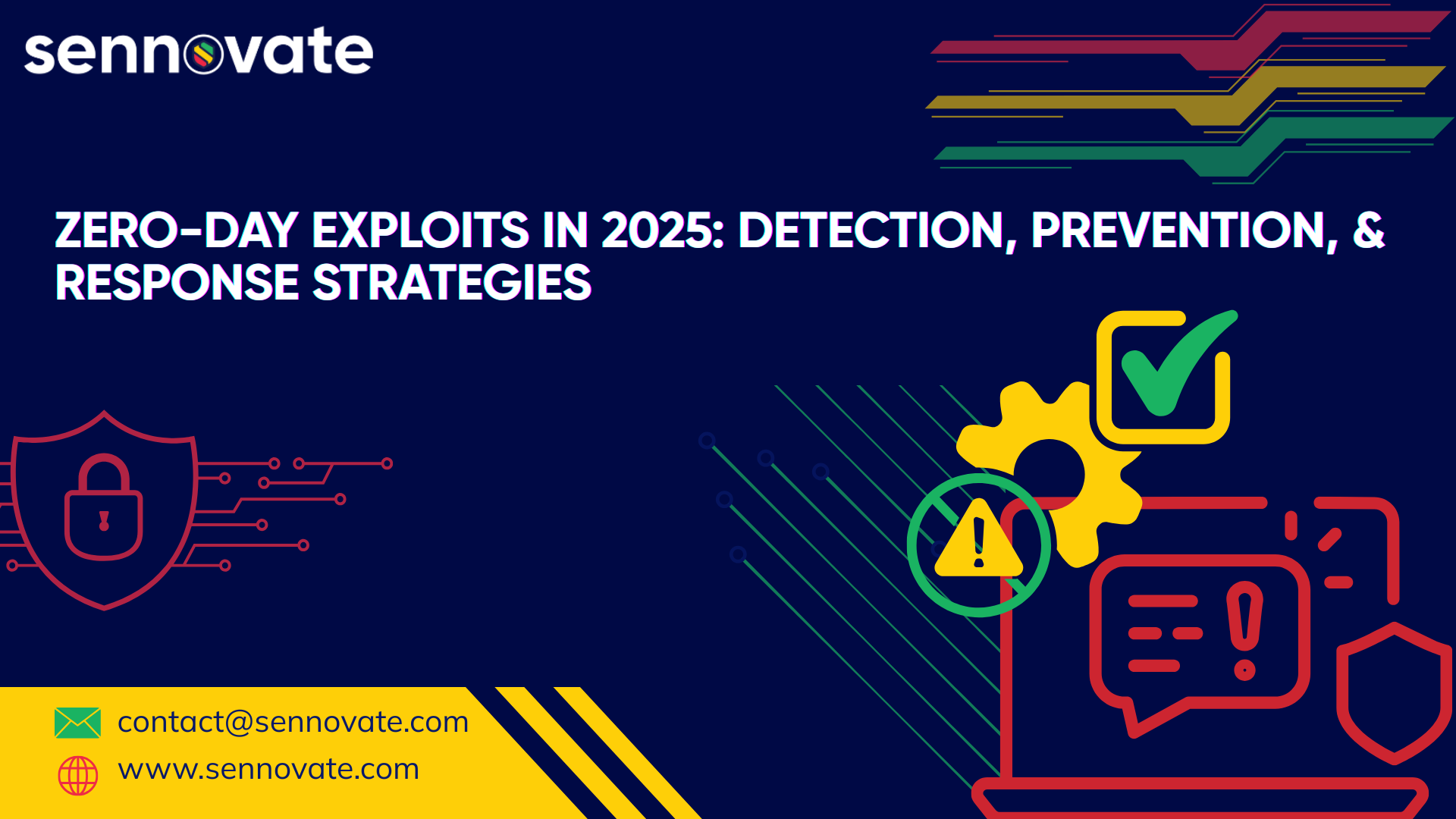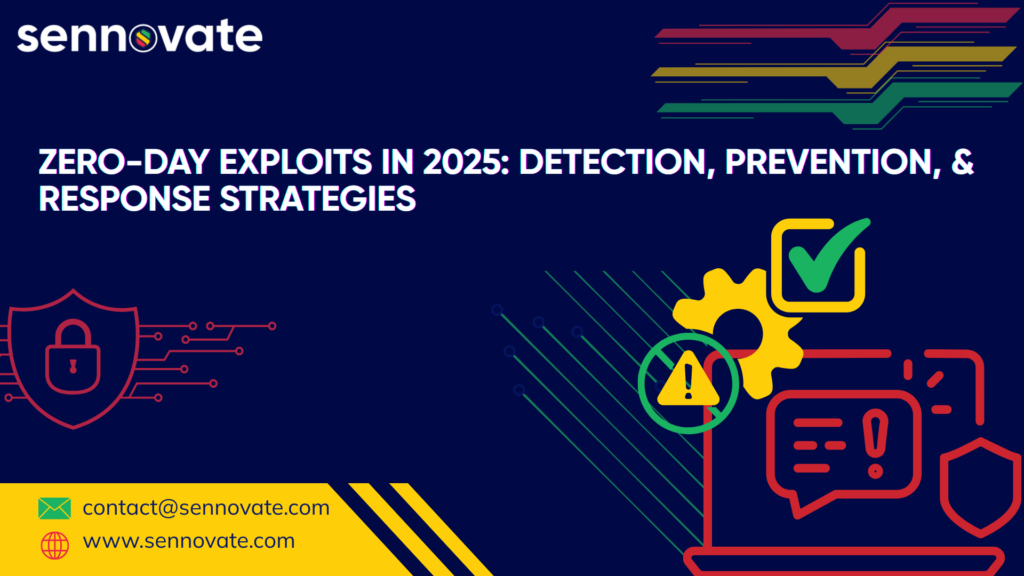
Zero-Day Exploits in 2025: Detection, Prevention, and Response Strategies


In the current fast-changing threat environment, zero-day exploits continue to pose one of the most significant cybersecurity threats. These attacks focus on undiscovered vulnerabilities in software, hardware, or firmware—leaving organizations with zero days to prepare before they are exploited.
As cybercriminals and state-sponsored actors increasingly utilize AI-enhanced zero-day attacks, businesses in the USA and around the world must implement proactive defense measures. This blog will cover:
✔ What zero-day exploits are and the reasons for their rise in 2025
✔ The industries that are most vulnerable
✔ Best practices for detection and prevention
✔ How Sennovate’s cybersecurity services in the USA can assist in risk mitigation
1. What Are Zero-Day Exploits?
A zero-day exploit attacks a previously undisclosed vulnerability—before developers can issue a patch.
Attack Lifecycle:
Discovery – Cybercriminals identify an unaddressed vulnerability (for instance, in Windows, iOS, or SaaS platforms).
Exploitation – Malicious software or intrusion methods leverage the weakness.Attack Execution – Incidents of data theft, ransomware, or espionage take place.Patch Release – The vendor addresses the vulnerability—but frequently after significant damage has occurred.
📌 Example: The 2024 MOVEit zero-day breach revealed over 60 million records globally.
Why Zero-Days Are Increasing in 2025
- Expanding Attack Surface (Cloud, IoT, AI systems create new vulnerabilities).
- Rise of Zero-Day Marketplaces (Sold for up to $10M per exploit on the dark web).
- AI-Powered Exploit Development (Automated vulnerability scanning accelerates attacks).
2. Industries Most Targeted by Zero-Day Attacks


3. How Zero-Day Exploits Are Evolving in 2025
Trend 1: AI-Generated Zero-Day Attacks
Automated Vulnerability Hunting – AI examines code for vulnerabilities more rapidly than human capabilities.
Polymorphic Malware – Modifies itself to avoid detection by signature-based systems.
Trend 2: Supply Chain Zero-Days
Cybercriminals penetrate software vendors to jeopardize numerous businesses (e.g., SolarWinds).
Trend 3: Ransomware + Zero-Day Combos
No-Patch Ransomware – Secures systems before a remedy is available.
4. How to Detect Zero-Day Exploits?
Behavior-Based Detection Approaches
✔ Endpoint Detection & Response (EDR) – Observes atypical process activities.
✔ Network Traffic Analysis – Identifies unusual data exfiltration.
✔ AI-Driven Threat Hunting – Detects zero-day patterns prior to breaches.
Tools for Zero-Day Detection
Microsoft Defender for Endpoint (Cloud-based behavioral analysis)
CrowdStrike Falcon (AI-enhanced threat intelligence)
Sennovate’s Managed Detection & Response (MDR) – Continuous zero-day monitoring
5. Zero-Day Prevention Strategies
1. Patch Management & Vulnerability Scanning
✅ Prioritize Critical Patches – Utilize automated solutions such as Qualys or Tenable.
✅ Virtual Patching – Implement WAFs and IPS as interim protective measures.
2. Zero Trust Architecture (ZTA)
✅ Micro-Segmentation – Restricts lateral movement following a breach.
✅ Continuous Authentication – Averts credential-based attacks.
3. Threat Intelligence Sharing
✅ Participate in ISACs (Information Sharing and Analysis Centers).
✅ Keep an eye on CISA Alerts – For new zero-day notifications.
6. Responding to a Zero-Day Attack
Incident Response Plan Steps
- Isolate Affected Systems – Contain the breach.
- Forensic Analysis – Identify the method of exploitation.
- Implement Compensatory Controls – Utilize virtual patching and establish firewall rules.
- Inform Stakeholders – Notify legal, public relations, and regulatory entities.
📌 Case Study: A US healthcare provider mitigated a zero-day attack via Sennovate’s IR team, preventing data loss.
7. How Sennovate’s Cybersecurity Services Protect Against Zero-Days
As a leading provider of cybersecurity services in the USA, Sennovate delivers:
🔹 Proactive Threat Hunting – AI-powered detection of zero-day vulnerabilities.
🔹 Managed Patching & Vulnerability Assessments
🔹 Zero Trust Implementation – Minimize attack surfaces.
🔹 24/7 SOC Monitoring – Prompt response to security exploits.
📞 Get a Free Zero-Day Risk Assessment – Secure your systems before attackers strike.
Staying Ahead of Zero-Day Threats in 2025
Zero-day exploits are growing more sophisticated, but with behavioural detection, Zero Trust, and expert partnerships, businesses can mitigate risks.
Don’t wait for an attack—proactively defend your assets today.






